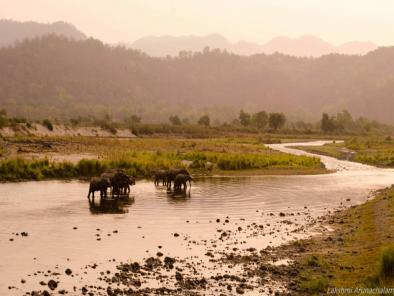Posted by: Lakshmi
When I think of wildlife holidays in the Northern part of India, the place that comes to my mind immediately is Jim Corbett, especially as it is close to the Himalayas. It is nestled in between Himalayas and Shivaliks in the state of Uttarakhand.
Though the state is famous for Garhwal, Kumaon, holy pilgrim sites like Badrinath, Kedarnath which are located amidst beautiful backdrops of Himalayas, it comes as no surprise when the first National Park (protected areas) of our country is set up here, Jim Corbett National Park in Nainital district.
As we navigate the tough terrain of Corbett in a jeep with bumpy rides for several hours searching for animals, we find our soul in this journey, and maybe you will leave a part of it there, like me.
History of Corbett National Park
The park was named after Jim Corbett, a famous British hunter who turned into a conservationist towards the later part of his life. He convinced the then British Raj to convert it into a National Park to protect mainly Bengal Tigers.
One of the top ten national parks in India (area-wise), Corbett, covering an area of 1300 sq.km. was established in 1936. As a remembrance to him, a statue of Jim Corbett is unveiled at the park entrance.
Altitudes inside the forest vary between 400 m to 1200 m, and the landscape is a wonderful mix of open grasslands interspersed between dense vegetation predominantly by Sal and Peepal Trees, lakes, hills, marshes, Ramganga river flowing like forest veins.
Close to 600 species of birds (including residents and migrants) and 500 species of plants and trees call Jim Corbett their home. A vast area of the park makes it easier for the animals to become elusive.
Though there are plenty of Bengal Tigers, good tracking is needed to spot them. During summer months, we can see one of the largest congregation of elephants too. Each herd might have more than a few hundred elephants at times.
Other animals such as Leopards, deer, otters, mongoose, yellow-throated martens, Himalayan Black Bear are also found here.
Zones of Jim Corbett National Park
Ecotourism is allowed only in designated zones inside the park. Many of the core zones remain closed during monsoon season due to heavy rainfall. Ramnagar is the closest city, and we need to hire gypsy vehicles (jeeps) for a safari inside the forest.
Bijrani Zone
It is the closest entry from Ramnagar. As we move past the gate, soon noise from the city fades away. Numerous birds you can spot on the way to the forest rest house, an erstwhile hunting complex now converted to accommodate visitors. Bijrani is an absolute wilderness, especially when night falls as there is no electricity here (be sure to charge your camera batteries). We are provided only with solar lamps. There is no mobile connectivity, too, which makes it the perfect retreat for a digital detox. Landscape in Bijrani is a mix of river plains and open grasslands. Elephant ride is available from this zone, which you can book on a first-come, first-serve basis. When we visited, “Sharmili,” the tiger crossed right in front of our jeep. It is an experience that would not fade away from our memory soon. They provide food in the canteen for an additional cost. A minimum of 4 safaris (2 days) is needed to cover the area.
Dhikala Zone
Arguably one of the most beautiful parts of the forests, entry from gate to forest rest house takes about an hour or so which passes through dense Sal forests. As we wait patiently in our jeep with only the sound of the wind blowing or an occasional rustling of leaves, our mind becomes calm and embraces silence.
Tallgrass sways gently in the wind and reveals spotted deer or endangered Hog deer foraging for food. It makes us realize the full fast city life we are leading and what nature has to offer. On a late evening, we were lucky to witness a herd of elephants cross the river near Sambhar road along with their little ones.
We watched them engage in a mock fight, smaller elephants pampered by others and big tuskers scattered here and there. The sunrise view from the reservoir located at one end of the zone is worth sacrificing our sleep. “Parvaali” is another famous tiger in this part of the jungle, and she is often very bold in front of the gypsy vehicles.
A minimum of 4 safaris (2 days) is needed to do proper justice. Dhikala forest house has various types of accommodation, which you can check here. It has patches of mobile connectivity for Airtel and BSNL. Buffet food provided is very good. There is also another small canteen that provides food for a cheaper rate (less tasty).
Durgadevi Zone
The Hilly zone of Durgadevi is a paradise for bird watchers. Varying altitudes, along with dense tree cover, provides an excellent opportunity to spot birds. Safari vehicles take you a little further after Domunda bridge, where we can spot the famous Mahseer fish. Plan to book one or two safaris in this zone.
Jhirna Zone
Although this zone is open throughout the year, weather and other conditions might make the forest department to close the entry, especially during monsoons.
Points to note about the Park
- A permit is required to enter the forest.
- Canceling or rescheduling the permit is not allowed after booking.
- Entry is restricted only to the zone for which permit is obtained.
- Walking or trekking inside the forest is prohibited except for a few places.
- Private vehicles are not allowed inside. We need to hire Gypsy from registered vehicles.
- Proof of identification (PAN card, Voter ID, etc) has to be shown at the entry of each zone.
- Canteen food is available only at Dhikala, Bhijrani zones. For other zones, the kitchen is provided where we can cook food.
- Avoid littering inside and do not shout/be noisy when spotting animals


